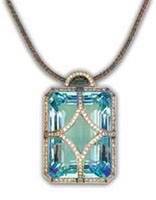The standard for determining the value of colored gemstones is not the same as for diamonds. A diamond is a single chemical element: carbon, and setting its value is strict and straightforward, namely defined by the 4 "c"s of cut, carat, clarity, and color.
However unlike diamonds, colored gemstones are not a single chemical element, but a combination of elements, as well as, falling into different families of stones. The most important characteristic in determining a colored gemstone's value is not clarity but color.While clarity is a consideration in evaluating the value of colored gemstones, it is a less important factor than it is for diamonds. In other words, inclusions (or internal flaws) are expected and more accepted in colored gemstones, as opposed to, diamonds.
What's more certain families (a/k/a categories or types) of colored gemstones have more inclusions than others.The GIA (Gemological Institute of America) doesn't rate colored gemstones like they do diamonds, nevertheless, they have created a system for classifying colored gemstones into 3 types based on clarity, i.e., their inclination or natural tendency to have internal flaws. Let's discuss them!
Type 1 are gemstones forming under the mildest geologic events and are found free of inclusions. They are eye clean and any inclusions they may have are so minor they are also loupe clean. It would take a powerful scope to detect any inclusions that exist. Type 1 gemstones include tanzanite, aquamarine, morganite, chrysoberyl, heliodor, blue zircon, blue topaz, and smoky quartz.Type 2 gemstones form under more difficult geologic events and have more inclusions than type 1, but are still eye clean. Corundum (sapphire, ruby), quartz (amethyst, citrine), alexandrite, spinel, peridot, all zircon except blue, and garnet are examples of Type 2 gemstones. Inclusions may be seen with a loupe and are accepted as long as they don't take away from the beauty of the stones.

Type 3 gemstones have formed under the most violent of geologic events, thus they are more prone to cracks, bubbles, and impurities that are visible to the naked eye. Green and red emeralds (also called red beryl or bixbite), and paraiba tourmaline are examples of type 3 gemstones. Despite having more inclusions than sapphires, rubies, or diamonds, emeralds are among the most valuable gemstones on earth. Eye clean emeralds make up only 1% of the planet's supply and are extremely rare. An emerald's inclusions (called Jardins) are caused by trapped gas, liquid, and other minerals during the stone's formation. So common, Jardins are accepted as part of an emerald's identity and uniqueness. Jewelers sometimes use the following terms to describe the clarity of colored gemstones, mostly when a specimen is heirloom quality and expensive:
Clarity ScaleIF – Internally Flawless
VVS – Very Very Slight Inclusions
VS – Very Slight Inclusions
SI – Slight Inclusions
I – Inclusions
TS – Translucent
O – Opaque
As color is everything in colored gemstones, experts consider 1) hue - the actual color, 2) tone - lightness to darkness from 1 - 10, and 3) saturation - from brightness to dullness.
Aren't nature's beauties awesome!
(<--Right image from Jewelry Television)Perfect is rare. Knowing color is the most important characteristic of colored gemstones helps you not miss out on some beautiful stones, and knowing which gemstones have more or fewer inclusions helps you either gravitate to the cleaner type 1 gemstones (above↑) ... or better yet, appreciate jewels in all their glory!

 I also keep my home organized, clutter-free, and easy to clean so I don't have to hire other people to help manage or clean it.
I also keep my home organized, clutter-free, and easy to clean so I don't have to hire other people to help manage or clean it.














































